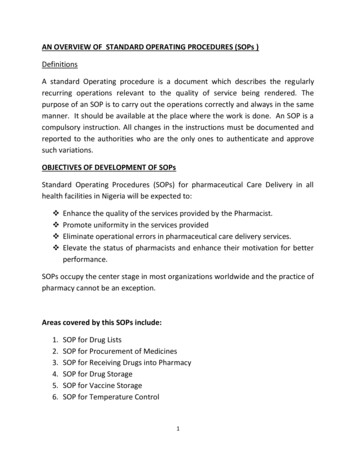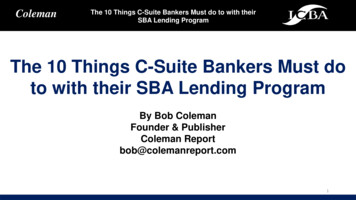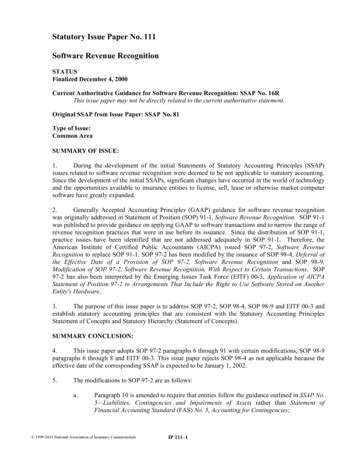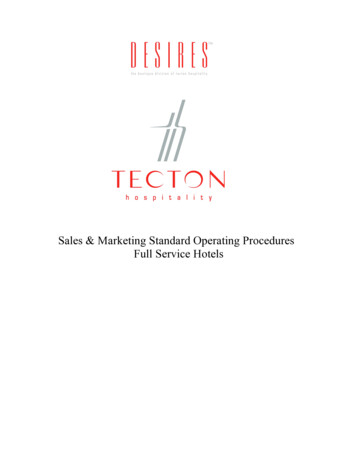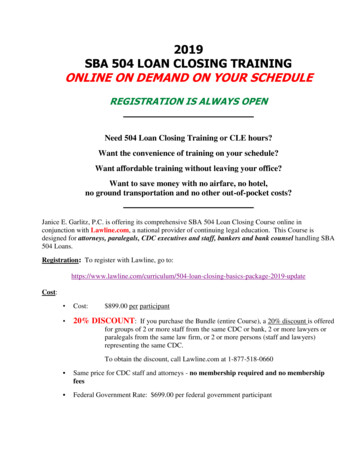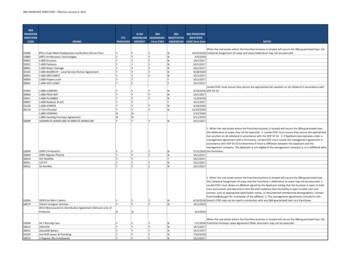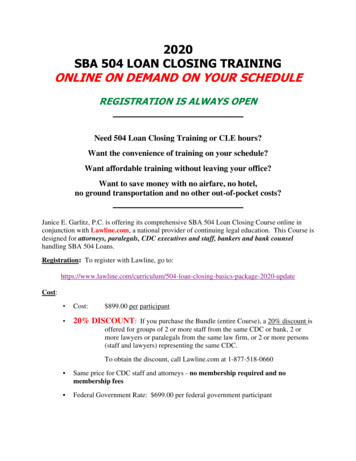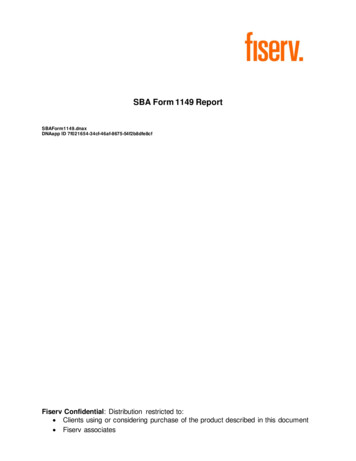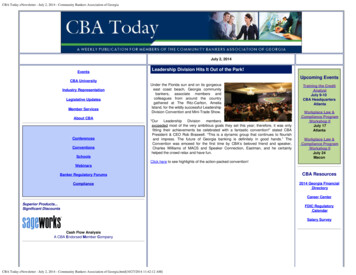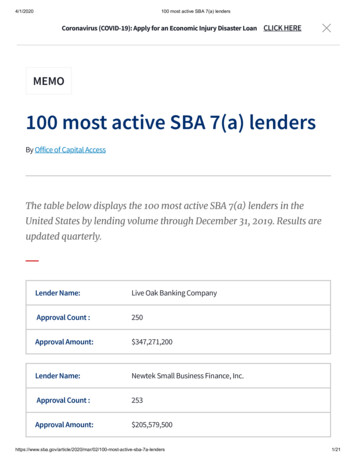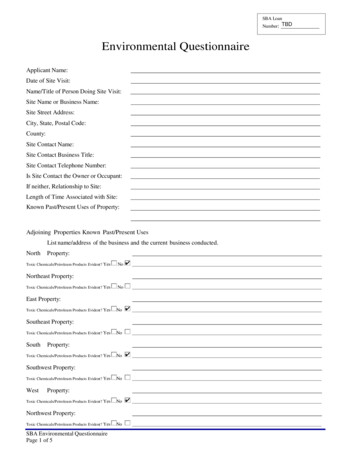
Transcription
SBA, SOP and Business, Real Estate and Going Concern AppraisalsControversy or Opportunity?By Scott Gabehart (BA,MIM,CBA,CVA,BCA)IntroductionThe current SBA policy document related to real estate and business acquisition loans isgenerally referenced as “SOP 50 10 5(F)” and is titled “Lender and Development CompanyLoan Programs”. As most industry participants know firsthand – and to the credit of the SBA the SOP 50-10 series has evolved substantially during the past five years with certain changesrelated to business or real estate valuation requirements among the most important.In day to day practice, the most direct coverage of real estate “appraisals” and business“valuations” as they apply to Section 7(a) business loan programs is found in:Subsection C (Appraisal and Business Valuation Requirements/page 171)Of Section II (Collateral/page 168)Within Chapter 4 (Credit Standards, Collateral and Environmental Policies/page 161)Of Subpart B (Section 7(A) Business Loan Programs/page 71)As an aside, note that Subpart C (Section 504 Certified Development Company LoanProgram/page 236) addresses the financing of fixed assets including land and buildings (realestate). Subsection A of Section II (Appraisal Requirements/page 290) addresses requirementsfor “commercial real estate” lending in a manner that is almost fully consistent with the coveragethat begins on page 171.Returning to Subpart B, the Appraisal and Business Valuation Requirements are addressedbeginning on page 171 of Subsection C. It is SBA’s chosen nuance to refer to commercial realestate as requiring an “appraisal” whereas a business requires a “valuation”. This choice isnot grounded in any particular set of professional standards, but has been somewhat consistentlyused throughout the years within the SBA community. This bifurcated terminology is the tip ofthe iceberg when it comes to identifying possible areas for improvement in the administration ofreal property and personal property appraisals.A few years ago, my colleagues (lenders and appraisers) and I floated a recommendation tofully separate the real property appraisal requirements from the business or personalproperty valuation requirements. It makes a good deal of sense to treat these two realmsseparately just as they are handled professionally, i.e. real estate appraisers can be state-licensedand are uniquely trained relative to business appraisers (and vice-versa). Besides separating thetwo realms, we put forth several specific recommendations on the business valuation sidewhich were partially accepted but largely put aside.One example of the confusion which still exists is the role played by USPAP in businessvaluations. While some accreditation groups require USPAP compliance, others do not. The1
SOP 50-10 references (mandates) USPAP requirements when discussing real estate appraisals,but NOT when discussing business valuations. Not only should USPAP be specificallyidentified as the required professional standards for business valuation engagements, they are infact already legally mandated via the Code of Federal Regulations (as per section 564.4 ofTitle 12 and other sections, as presented shortly).One of the positive changes implemented was the institution of the invaluable requirementsthat a business appraiser be certified via one of the top BV credentialing organizations and“regularly receive compensation for business valuations”. There have been a series of iterationsin this regard with CPA’s once allowed but now disallowed (unless they have one of thequalifying BV credentials) and AVA’s once not allowed but currently allowed. Most recently, achange involving the “going concern” appraisals and appraisers has ignited confusion andcontroversy which has been the topic of the Senate Confirmation Hearings for Maria ContrerasSweet (Administrator of SBA) and debate among lenders and appraiser groups alike as to whocan perform these unique assignments involving both real and personal property.Despite the extra attention and definite improvements implemented since 2008, the bottom line isthat there is still a great deal of uncertainty among lenders and appraisers alike withrespect to various key components of the SOP 50-10 (5)(F) policy and what is proper andacceptable for the ultimate purpose of sustaining the pivotal “guarantee” whichaccompanies SBA loans. The overall impact of such uncertainty ultimately includes the delay oroutright avoidance of completing the loan process to the detriment of our nation’s smallest butjob-creating enterprises.To complicate matters, the ultimate or source regulations governing all SBA appraisalrequirements are set forth in the Electronic Code of Federal Regulations within Title 13(Business Credit and Assistance) and Part 120 (Business Loans). Less frequently cited is theconnection to Title 12 (Banks and Banking), which lays out requirements pertaining to“federally related transactions”. As shown later, it is Title 12 which provides the strongestsupport for business appraisers following Uniform Standards of Professional Appraisal Practiceor USPAP.At the same time, business and real estate appraisers must adhere to one or more sets of theirown “professional standards” beyond USPAP – all of which can be “overwritten” by actualSBA policy due to the “jurisdictional exception” rule that permeates such standards. This rule ispotentially very important as it allows the SBA (federal government) to clarify its definitivepreferences with respect to what a “qualified appraisal” might or should contain, i.e. the SBAhas the authority to direct the herd in a uniform direction to the benefit of all concerned parties.What type of policy changes would benefit the SBA community? At the broadest level,simply clarifying that all business valuations must be prepared in conformity with USPAPwould eliminate wide and deep swaths of potential confusion among appraisers today. Equallyimportant are issues such as “qualified appraiser” criteria, both in general and most recently asit pertains to the valuation of so-called “special use” or “mixed use” or “going concern”appraisals.2
Why USPAP?Although there are material differences between USPAP and say the AICPA or NACVA/IBAstandards (ASA appraisers must adhere to USPAP already) and each set has its pluses andminuses, USPAP represents an equally viable and somewhat independent source ofbusiness valuation standards. In addition, USPAP is specifically mentioned by the IRS as anexample of “professional standards” which are linked to a “qualified appraisal”.USPAP is the only set of professional standards which incorporate BOTH real property andpersonal property (business interests) appraisals. The advantages of universal businessvaluation standards would be wide-ranging and to the benefit of the entire SBA community.After years of contemplation and research, I have determined that federal law (section 564.4 ofTitle 12) mandates the use of USPAP for any “federally related transaction”.§ 564.4 Minimum appraisal standards.For federally related transactions, all appraisals shall, at a minimum:(a) Conform to generally accepted appraisal standards as evidenced by the UniformStandards of Professional Appraisal Practice (USPAP) promulgated by theAppraisal Standards Board of the Appraisal Foundation, 1029 Vermont Ave.,NW., Washington, DC 20005, unless principles of safe and sound bankingrequire compliance with stricter standards;(b) Be written and contain sufficient information and analysis to support theinstitution's decision to engage in the transaction;USPAP relevance for SBA change of ownership loans appears to come down to interpretationsof whether the 7(a) loans are “federally related transactions” and a “real estate related financialtransactions”. There are creative arguments “pro and con” with a bias towards mandatorycompliance in my opinion. As per the CFR (section 225.62, Title 12):(f) Federally related transaction means any real estate-related financial transactionentered into on or after August 9, 1990, that:(1) The Board or any regulated institution engages in or contracts for; and(2) Requires the services of an appraiser.(h) Real estate or real property means an identified parcel or tract of land, withimprovements, and includes easements, rights of way, undivided or future interests,or similar rights in a tract of land, but does not include mineral rights, timberrights, growing crops, water rights, or similar interests severable from the landwhen the transaction does not involve the associated parcel or tract of land.(i) Real estate-related financial transaction means any transaction involving:(1) The sale, lease, purchase, investment in or exchange of real property,including interests in property, or the financing thereof; or(2) The refinancing of real property or interests in real property; or3
(3) The use of real property or interests in property as security for a loan orinvestment, including mortgage-backed securities.Others argue that any loan whereby the federal government has a “vested interest” is afederal transaction. Banking Circular 225 (1991) defined a Federally Related Transaction as"Any transaction by any federally regulated institution, requiring the services of anappraiser." The reality is that very few business appraisers have diligently investigated theCFR vis-à-vis the evolving SOP 50-10 series, somewhat blindly “assuming” that one approach oranother is correct or acceptable. Interestingly, the real estate appraisal section of the SOP doesin fact stipulate USPAP compliance.Going Concern Appraisals and the Qualified Source AttributeA more current source of confusion revolves around the unique area of “going concernappraisals” for “special use properties”. The typical SBA loan involving a business and realestate will require two different loan types (504 and 7a) and require both a business valuationand real estate appraisal. While all transfers of businesses require a valuation; those over 250,000 require formal 3rd party business valuations with loans under 250,000 subject tointernally-prepared valuation analysis.The PRIOR SOP (Version E) allowed real estate appraisers to perform going concernappraisals provided that they had taken a special course offered by the Appraisal Institute. A realestate appraiser WITHOUT one of the qualified business valuation designations (ASA, CBA,ABV, CVA and AVA) COULD perform a going concern appraisal if he or she“ has successfully completed the Appraisal Institute course "Fundamentals of SeparatingReal and Personal Property from Intangible Business Assets";and(3) The appraisal allocates separate values to the individual components of the transactionincluding land, building, equipment and intangible assets.The NEW SOP (Version F) has eliminated this last option and effectively requires a“certified” or “qualified” business appraiser to perform all going concern or special useproperties when there is at least 250,000 in goodwill value and a business loan is being made.The top of page 175 reads as follows:e)The lender may use a going concern appraisal to meet these requirements if:1.The loan proceeds will be used to purchase a special use property;2.The appraisal is performed by an appraiser experienced in the particular industryand who is a “qualified source” as identified in paragraph 5.c) above and3.The appraisal allocates separate values to the individual components of the transactionincluding land, building, equipment and intangible assets.Prior to the recent change from SOP 50-10 E to SOP 50-10 F, apparently in the case ofservice stations, both the real estate and business value could be appraised under a single“going concern appraisal”. It is often the case that the business or intangible value for these4
special use properties is less than 250,000, theoretically precluding the business valuationrequirement.The SBA requires the breakdown of a going concern appraisal to include allocations to land, realestate, equipment and intangible asset value. From the lender’s perspective, a primary emphasisis on proper allocation and the identification of the real estate value. In the case of WellsFargo, Bank of America, California Bank and Trust and other banks recently surveyed by anactive SBA specialist – most lenders indicate an interest in (strongly prefer) only lending on realestate and not on any other elements such as intangible or blue sky value (particularly in the caseof gas/service stations).A large number of banks have experienced high historical losses by erroneously lending on thegoing concern value and not against the real estate only value. Although there are many goingconcern-based properties, the new SOP does not specifically identify any of them. Commonexamples include:1) Assisted living and nursing homes2) Car washes3) Cemeteries4) Daycare facilities5) Golf courses6) Grocery stores7) Hospitality businesses such as hotels, motels, inns, etc.,8) Lube facilities9) Nurseries10) Parking lot services11) Restaurants (in some cases).12) RV parks13) Sand and gravel mining operation14) Service stations and c-stores15) Self-storage facilities16) Water companiesOne problem therefore is the fact that it is simply unclear which types of going concernproperties fall under this new requirement (not to mention what the actual report contentrequirements are and who may be qualified to review this type of work, etc.). One lenderwas informed by a chief appraiser of a small bank in southern California that he was instructedthat hotels would not be included in the going concern category. Thus, lenders appear to bereceiving contradictory and unclear direction on the properties from SBA sources. Somesmaller lenders are opting to avoid all special use properties altogether due to this uncertainty.Recognizing that a going concern appraisal is a real estate analysis and not a business valuationas such, the recent change in the SOP nonetheless removed MAIs (Members of the AppraisalInstitute) and other real estate appraisal professionals as a qualified source for doing goingconcern appraisals and implies that only business valuators are qualified or an MAI mustpair up with a “qualified business valuator” to complete a going concern appraisal. Many5
believe that there is a lack of clarity regarding this requirement, calling for changes to the SOP assoon as possible.Using the going concern valuation of a service station as an example the real estate appraiser(who specializes in this type of going concern) may have collected hundreds of data sets andcaptured the details of sales which include the acquisition of the going concern. Some sales areby the owner-operators and include only the real estate component. The skilled appraiser sortsout these transactions by type. In short, trained real estate specialists may have superiormarket data which includes both the real estate and other intangibles acquired. Personalproperty is typically handled separately in these transactions as well as inventory, tools,etc. Once the analysis is complete, the real estate appraiser allocates value to land, real estate,depreciated fixtures and then finally intangible value. The emphasis is on isolating the real estatecomponent of value. The intangible value or blue sky is what remains “at the end”.A business valuation does not normally have detailed real estate transaction information,but examines the income characteristics, risk and approaches the valuation from the incomestream and not the real estate. In many cases, the business valuator will factor in a market levelrent as a means of excluding the real estate value (treated as non-operating revenues/expensesand assets/liabilities) from the business analysis. Business valuation comparable sales data oftendo not include real estate values and it is therefore very difficult if not impossible for someonewho strictly engages in business valuations to perform a true going concern appraisalinclusive of real estate value.Some banks are trying to pair up real estate and business valuators under the cover of asingle report. This is somewhat of an unnatural pairing and business valuators will think twicebefore signing a report and assuming liability for the work of a real estate appraiser which goesfar above their business valuation exposure (which in turn is likely to be a relativelysmall portion of the total value).The Appraisal Institute, the American Society of Farm Managers and Rural Appraisers and theAmerican Bankers Association recognized quickly that this change effectively excludes realproperty appraisers from performing going concern appraisals (without a BV credential)and have complained to the SBA that:“The new policy will increase costs on consumers and lenders, delay the processingof loans and complicate bank reconciliation processes, as bank appraisal andunderwriting departments attempt to reconcile and interpret two incomparablereports.”On the other hand, the American Society of Appraisers appears to be trying to work thechange in their favor by claiming that an ASA (Accredited Senior Appraiser) with a real estatespecialization can in fact perform the going concern appraisals based on the SOP reference to theASA (American Society of Appraisers) as a qualified source of credentialing. The problem that Ihave with this is that the list of qualified source credentials in the “business valuation”section included only those ASA’s with a business valuation specialty – not real estate (orfixed assets, etc.).6
At the same time, the Commercial Real Estate appraisal requirements found on page 290(Subpart C) for Section 504 loans reads as follows:7.If the appraisal engagement letter asks the appraiser for a business enterprise orgoing concern value, the appraiser must allocate separate values to the individualcomponents of the transaction including land, building, equipment and business(including intangible assets). When the collateral is a special purpose property, theappraiser must be experienced in the particular industry.What this appears to suggest is that if there is a real estate loan ONLY (504 program), the realestate appraiser may perform the going concern appraisal that includes a reference to goingconcern value or business enterprise value.What Is or Should Be a “Qualified Source”?There are other issues percolating with regards to the “qualified source” criteria in theSOP. A brand new credential known as the “Business Certified Appraiser” (BCA) has beenrecently created by the International Society of Business Analysts (ISBA), which is the sisterorganization of the NEBB Institute that offers the equipment appraisal designation CertifiedMachinery and Equipment Appraiser (CMEA). Led by longtime Institute of BusinessAppraisers Executive Director Mr. Howard Lewis, the new BCA program has been designed tofocus squarely on providing real and ongoing support to the would-be business appraiser byproviding practical education, support of an active network, assigned mentors and an innovative“tool chest” exclusively for its members.If it is the case that the BCA credential is based on equal or greater standards andqualifications than the other designations, why would BCA’s not be allowed as a “qualifiedsource”? Mr. Lewis was actively involved with the IRS when it was investigating the qualifiedappraiser and qualified appraisal issue and they went to great lengths to avoid identifying anyparticular credential for fear of appearing biased or preferential in its treatment of serviceproviders. After long and careful analysis, the IRS opted for an experience and capabilitiesdriven definition for a “qualified appraiser” and thereby avoided the current set of challengesfacing the SBA.A “qualified appraiser” is an individual who has earned an appraisal designationfrom a recognized professional appraiser organization, if the designation is awardedon the basis of demonstrated competency in valuing the type of property for whichthe appraisal is performed, or has otherwise met minimum education andexperience requirements set forth by the Secretary.For property other than real property, the appraiser will be treated as having metminimum education and experience requirements, for returns filed after February16, 2007, if she has (A) successfully completed college or professional-levelcoursework that is relevant to the property being valued, (B) obtained at least twoyears of experience in the trade or business of buying, selling, or valuing the type ofproperty being valued, and (C) fully described in the appraisal the appraiser’s7
education and experience that qualify the appraiser to value the type of propertybeing valued.An additional requirement to being a qualified appraiser is that the individualregularly performs appraisals for which she receives compensation. Furthermore,the individual will not be treated as qualified if she has been prohibited frompracticing before the IRS at any time during the three year period ending on thedate of the appraisal. The determination of whether an appraiser is qualified mustbe based on the appraiser’s qualifications as of the date the appraisal is made.Concluding Thoughts and a Call for ActionHaving been involved with SBA business valuations for nearly 20 years now (as a businessbroker and business appraiser, including my new role as Chair of the SBA Valuation IssuesCommittee of the ISBA), I have witnessed an increasingly active and proactive SBA in therealm of 7(a) and 504 loans generally and specifically with respect to business valuationrequirements. Despite the real progress unfolding since 2008, there is still much room forimprovement across the valuation and appraisal spectrum.I am routinely contacted by business appraisers and lenders with an array of questions involvingthe “what, why, when, how and who” of these ever-changing business valuation requirements.Besides the question of “who” can perform these engagements, there is a great deal ofuncertainty as to “how” to prepare the reports and how to determine “what” type ofreports are acceptable. A few sample questions are:1. Is a summary or limited or “calculation report/calculation value” acceptable forSBA loan purposes and what is the minimum acceptable scope of work?2. Are the USPAP requirements applicable to business appraisers or only realproperty appraisers?3. Can or must the synergistic benefits associated with the known buyer beincorporated into the valuation analysis as it relates to the ability to repay the debt?,i.e. can or should investment value be used in lieu of fair market value?4. Is a separate valuation of equipment needed beyond the business valuation and realproperty appraisal?5. Is a site visit mandatory or optional?6. What is the appropriate or required valuation effective date?7. Is there any type of formal review process used by SBA personnel?With the current uncertainty revolving around the “qualified source” requirements (ingeneral and specifically with respect to going concern appraisals) possibly preventing loans fromtaking place, it would be beneficial for all stakeholders to have an opportunity to meet jointlywith SBA personnel to discuss, debate and help refine the current SOP 50-10 (5) F appraisalpolicy. In light of the recent administrative changes at the highest levels of the SBA and theirproven willingness to work closely with stakeholders, this may be an opportune time for a“Valuation Summit” with representatives from each of the primary disciplines (real estate,8
business and equipment) and each of their respective professional organizations meeting todiscuss a predetermined set of core issues currently in need of attention.Scott Gabehart is a business appraiser and Vice-President of Bizequity, LLC and serves asthe Chair of the SBA Valuation Issues Committee of the ISBA. He has performedhundreds of SBA business valuations and is an author and former faculty member atThunderbird where he taught a course on private firm valuation for 7 years.9
AppenndixThe folloowing comppares the prior and current SOP veerbiage withh respect too appraiserrequiremments:SOP 500-10 F (currrent version – pagee 174)SOP 500-10 E (priior versionn – page 194)10
11
Going Concern Appraisals and the Qualified Source Attribute A more current source of confusion revolves around the unique area of "going concern appraisals" for "special use properties". The typical SBA loan involving a business and real estate will require two different loan types (504 and 7a) and require both a business valuation
